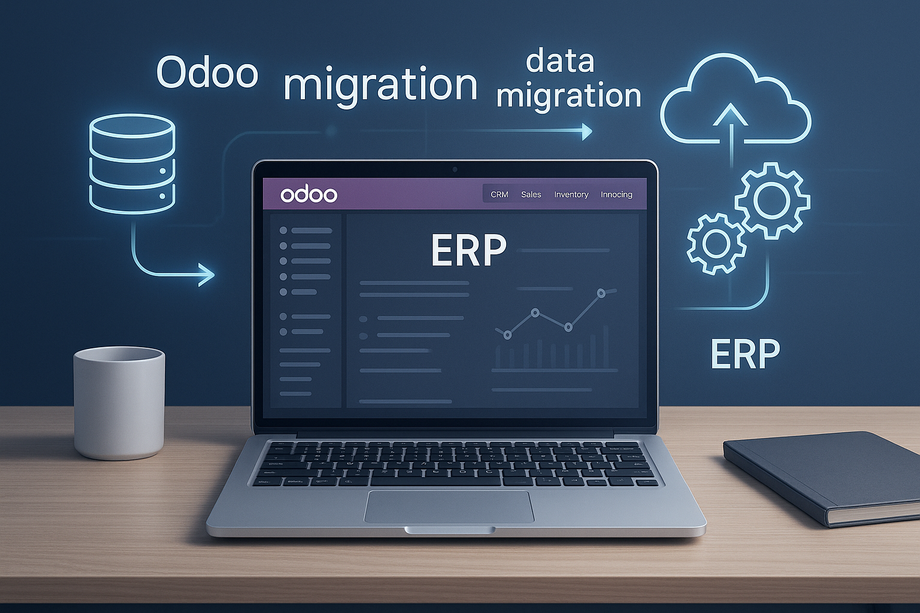A Complete Guide to Odoo Data Migration Without Data Loss
Odoo Data migration might sound like a headache but with the right approach, it doesn’t have to be. Whether you're upgrading your ERP system or switching to a newer Odoo version, ensuring that your valuable business data moves safely and smoothly is key.
This guide will walk you through Odoo data migration best practices, tools, and the importance of using professional Odoo migration services to ensure success without any data loss.
What is Odoo Data Migration?
Odoo data migration is the process of transferring all your existing data like customers, products, sales, inventory, accounting, and more from one Odoo version to another. It’s essential when upgrading from an older version (e.g., Odoo 12 to Odoo 18) or when switching from another ERP to Odoo.
Why is Odoo Migration Important?
Odoo continuously rolls out new versions with improved features, better performance, and enhanced security. But to benefit from these upgrades, you must migrate your existing setup. This includes both your data and custom modules, which together form the backbone of your ERP.
Here’s where Odoo migration becomes crucial especially when you want to retain full functionality without losing any critical business information.
Odoo Migration: The Two Main Parts
1. Data Migration
This involves moving all database records such as:
-
Customers and vendors
-
Sales and purchase orders
-
Products and inventory
-
Accounting records
-
HR and payroll data
2. Code Migration
This includes:
-
Custom modules and apps
-
Themes and UI changes
-
Automation scripts or third-party integrations
Odoo migration services typically handle both parts to ensure complete system functionality in the new version.
Common Risks in Odoo Data Migration
Before jumping into the process, it's important to understand what can go wrong:
-
Data loss or corruption during transfer
-
Incompatibility of custom modules in the new version
-
Downtime, affecting business operations
-
Broken workflows if dependencies are missed
-
Security gaps due to outdated practices
That’s why it’s recommended to hire experienced Odoo migration services to handle the task professionally.
Step-by-Step Odoo Data Migration Process
Let’s break it down into manageable steps:
Step 1: Analyze Your Current System
Start by performing a full system audit. Identify:
-
Your Odoo version
-
Installed modules (default + custom)
-
Third-party apps
-
Data size and complexity
This will help in planning the entire Odoo migration roadmap.
Step 2: Choose the Target Odoo Version
Always aim for the latest stable Odoo version. Newer versions offer better UI, faster processing, enhanced features, and improved security. Your chosen Odoo migration services provider can guide you based on your business needs.
Step 3: Backup Everything
Before moving even a single record, create a complete backup of your current database and files. This ensures that you can always revert to the original setup in case of any issues.
Step 4: Clean & Prepare Your Data
Before migrating, remove duplicate, outdated, or irrelevant entries. Clean data ensures faster and more reliable Odoo data migration.
Step 5: Test Migration on Staging
Never migrate directly on your live system. Always test on a staging environment. This allows:
-
Error identification and debugging
-
Testing module compatibility
-
Validating workflows
-
User acceptance testing (UAT)
Step 6: Perform the Live Migration
Once everything works on staging, schedule the live migration during non-peak hours to avoid downtime. Odoo migration team is available for any last-minute support.
Step 7: Post-Migration Checks
After going live, perform a full system check:
-
Verify data integrity
-
Test user roles and permissions
-
Check module functionality
-
Confirm reports and dashboards work as expected
Why Use Professional Odoo Migration Services?
Let’s face it Odoo data migration isn’t a DIY task unless you're an expert.
Here’s why professional Odoo migration services are worth every penny:
-
Zero data loss: They use tried-and-tested tools for precise migration.
-
Faster execution: Experts reduce downtime and complete migration quickly.
-
Customization support: They adjust your custom modules for compatibility.
-
Post-migration support: For any bugs or issues that arise after going live.
-
Security compliance: They follow best practices to protect your data.
Best Practices to Avoid Data Loss During Odoo Migration
-
Always use a staging environment
-
Run multiple backup versions
-
Work with certified Odoo developers
-
Communicate with your team before and after the migration
-
Monitor performance post-migration for at least 1-2 weeks
Tools Commonly Used in Odoo Data Migration
-
OpenUpgrade: A popular open-source tool for migrating database schemas.
-
Odoo Scripts: Custom scripts created by developers for data handling.
-
ETL Tools: Used to Extract, Transform, and Load data cleanly.
Your Odoo migration services provider will recommend the right tools based on your project size and structure.
Final Thoughts
Odoo migration may seem daunting at first, but with a strategic approach and expert help, it becomes a smooth transition. Whether you're upgrading to enjoy new features or switching from a legacy ERP, always treat Odoo data migration with the care it deserves.
Don’t risk your valuable business data trust reliable Odoo migration services for a secure, fast, and seamless upgrade.
Post Your Ad Here

Comments (1)
iVenture Team3
Best Odoo ERP Development Company
Thanks for sharing such a informative article.